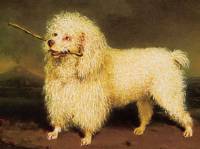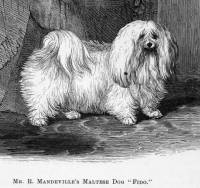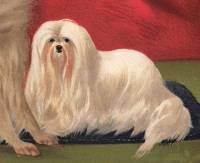Maltese and Bolognese
 Maltese
Maltese
Many toy breeds descend from the forerunners of the Maltese which have been adored continuously as a small companion dog since the earliest civilizations. Their development demonstrates the effect of trading small dogs between the East and the West. Maltese history is summarized here, together with documentation from many respected sources.
History of the Maltese
 Maltese 1819
Maltese 1819
 Maltese 1862
Maltese 1862
Below is some of the documentation that supports the theory that the type of dog known today as a Maltese, dates continuously back to Aristotle's time (384 BC -322 BC) making it one of the the oldest of the 'Toy' breeds. Without DNA and the pedigree authentication available today, here is some early documentation[1]:
- c 350 BC - Small European companion dogs were introduced into China in the years Before Christ through trade routes. They were exchanged for Chinese silk which was in great demand in Greece and Rome. They were also presented as gifts in diplomatic missions
- c 20 AD Roman poet Strabo called these small dogs 'Canis Melitei'[5]
- 3,000 - 1200 AD - Chinese dogs similar to 'Lion Dogs' were introduced into Europe
- 1570 (Caius) - a 'Comforter or Spaniel Gentle sought after for the pleasure and amusement of women'
- 1588 (Harrison) - 'Melitei' dogs came from the Island of Malta from where they were brought hither'
- 1607 (Topsell) - 'Not above a foot long.. their head is like the head of a mouse, short legs, little feet, long tail, white colour and the hairs about the shoulder longer than ordinary are most common. They are of pleasant disposition'
- 1777 (Buffon) - 'The most ancient of all spaniel races.... so small that ladies carried them in their sleeves...'
- 1819 (Rees) - 'An attendant of the ladies at the toilet or in the drawing room'
- 1847 (Richardson) - 'a small poodle with silky hair instead of wool' classified as terriers'
- 1862 (Stonehenge ref [6]) - 'Mr Mandeville's strain, which has kept possession of the show bench sine 1862, was well established at the Agricultural Hall Show, in which Mr Mandeville's Mick and Fido were first and second'.
- 1878 (Stonehenge) - 'the pure white coat is long and silky, no woolliness permitted.. not exceeding 5 or 6 pounds'
- 1904 (Gordon Staples) - 'the Maltese Toy Dog' would be a better name for this breed than 'Maltese Terrier' as there is nothing of the terrier in it.'
The Maltese becomes a Pure Breed
 Maltese 1875
Maltese 1875
As Maltese were entered in the first dog Show held in England in 1859, 24 are listed in the First English Stud Book, including Lady Giffard's "Hugh" (pictured). It is interesting to note that from 1859 to 1951, 2,769 Maltese had been registered in these English Stud Books[1a]. As this period spanned both World Wars when records of so many breeds were destroyed or otherwise lost, the Maltese is one of the very few of today's pure breeds whose records are continuous.
History of Maltese in Australia
Two 'Maltese Spaniels', an unnamed bitch was imported in 1893 followed by a dog in 1907[2]. No further reliable records of Maltese arriving here could be found until 1949 when Mrs De Pellette arrived in Western Australia with five Maltese. Three of these were Eng Ch Invicta Accius, Invicta Puffin and Whiteinch Tom-Tit who was from parents carrying the 'Invicta' prefix, plus two other Maltese. These founded the Maltese breed as we know it across Australia and New Zealand today[3]. The attached footage was shot in the early 1970's by Bill Dalzeil, husband of the former Trudy Pamment who was very successful in Maltese during this period. It is interesting to note not only how the dogs have changed, the Royal Melbourne Showgrounds has long gone, and card tables have been replaced by secure judging tables!
The Maltese Today
 Maltese
Maltese
The Maltese is a pure white dog standing around 10 inches (25 centimetres) high. It's crowning glory has always been its white long, perfectly straight coat which should never be woolly. Nor should it be so long that it impedes the dog's straight and free-flowing movement.
The head should impart a sweet tempered and intelligent expression. When looking at the head from the front, a line drawn from the back of the skull to the stop should be double the length of the muzzle. The stop should be well defined and the nose and eye-rims should be pure black.The dark brown eyes should be oval and not bulging. The ears should be long and well feathered and hang close to the side of the head. The hair on the ears should mingle with the coat on the shoulders. The Maltese should have a normal scissors bite or a level bite with even teeth.
The neck is of medium length, the shoulders are well sloped and the legs should be short and straight. The short, cobby body should be well balanced with a good spring of rib, creating a straight topline from the tip of the shoulders to the well feathered tail which is arched over the back. The feet should be round with black pads. The gait should be straight and free-flowing without weaving in the front but when viewed from the rear the legs should be neither too close nor too wide apart.
Bolognese
With an origin closely connected to the Maltese, the Bolognese was only recognized by the FCI in late 2015[4]. He can stand almost 12 inches (30 cms) high so he is generally a taller dog than the Maltese and more squarely built. The head is also proportionately a little longer. But the major difference is the coat which forms long flocks that should have the same texture all over the body. This is a rather off-standing coat which does not not fall flat and tight.
References and Further Reading
[1] Virginia T Leitch 2nd Edition revised and updated by Dennis Carno - 'The Maltese Dog' Published by IIVS, International Institute of Veterinary Science, New York 1970 Chapter II 'The origin and development of the Maltese Dog' Pages 5 - 46
[1a] Ibid., Chapter III 'Development of the Maltese Dog' - Maltese Dogs in England Page 52
[2] "Tyzack's Annual" Compiled by T. W.Tyzack and C.S.Turner Published by the Victorian Poultry and Kennel Club Printed in 1912 by Bellamine Bros. Printers, 66-70 Flinders Lane Melbourne Importations Page 101
[3] Tom Tancred - National Dog Newspaper 'The Maltese - Toy Dog from Ancient Times' July 1977 Pages 11-12.
[4] FCI Standard No 196.
[5] Jackie Ransom - 'The Bichon Frise' Published by H F & G Witherby Ltd LOndon WC2E 8QJ ISBN 0 85493 193 7 CHapter 1 History of the Breed Page 9
[6] J.H.Walsh, under the name 'Stonehenge', 'The Dogs of the British Islands' (Fifth Edition) Published by 'The Field' Office, 346 Strand, W.C.London 1886. Part lll Non-Sporting Dogs Book lV, Toy Dogs, Chapter l, Rough-Coated Toy Dogs. The Mathese Dog Pages 269 -270